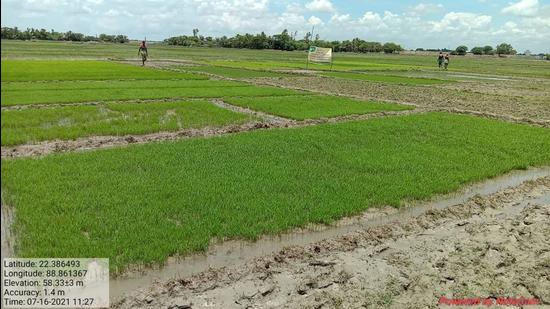Back-to-back cyclones prompt Bengal farmers to shift to salt tolerant paddy
Three cyclones - Bulbul in November 2019, Amphan in May 2020, and Yaas in May 2021 – have highlighted the state’s vulnerability to the climate crisis. Over the years, farmers living in the coastal belt of West Bengal have been gradually shifting to salt-resistant paddy
In May, when cyclone Yaas was tearing through Odisha, 51-year-old Ananda Das, a farmer from Sandeshkhali in West Bengal’s North 24 Parganas district, was devastated. With his farmlands all submerged under saline water, which gushed into the villages through breaches in the river embankments, the future seemed bleak. Three months down the line, Das has something to rely upon. He along with fellow villagers, whose farmlands have also turned saline, are now growing salt-tolerant varieties of paddy, which were grown in community seedbeds on higher grounds with the government’s help.

“The yield could be a bit less compared to what we used to get from the high yielding variety (HYV) of paddy. But in such highly saline conditions, the HYV won’t survive. We would get at least some yield from the salt-tolerant varieties,” he said.
Three cyclones - Bulbul in November 2019, Amphan in May 2020, and Yaas in May 2021 – have highlighted the state’s vulnerability to the climate crisis. Over the years, farmers living in the coastal belt of West Bengal have been gradually shifting to salt-resistant paddy.
After Amphan, the West Bengal government distributed around 550MT of salt-tolerant varieties of paddy seeds to around 91,000 farmers. After Yaas, around 1200 MT of seeds were distributed in the three coastal districts.
“Each farmer was given a kit comprising six kilos of seeds along with seed-treating chemicals. Six varieties of paddy seeds – CSR-10, CSR036, CSR-43, Luna Swarna, Luna Sampad, Lunishree and Dudeshwar were distributed. Luna Swarna was distributed for the first time,” said Onkar Singh Meena, secretary of the state agriculture department.
Also Read | Bengal professors’ body questions rationale behind ‘drinking poison’ by teachers
Government officials said that with this 1200MT of seeds, salt-tolerant paddy could be grown in around 38,890 hectares of farmland which in turn will benefit around 30,00,00 farmers if all goes well.
“With an estimated yield of at least three MT per hectare, if not more, we are expecting that the production would be around 1.16 lakh MT. This would be worth around ₹217.9 crore instead of zero crops because of high salinity levels after the cyclone. On average an HYV paddy yields around five MT per hectare,” said an official.
As cyclone Yaas coincided with the perigean spring tide, it triggered a huge storm surge up to a few metres high and saltwater gushed into the villages. Nearly 1.42 lakh hectares of farmlands in three coastal districts – East Midnapore, North 24 Parganas, and South 24 Parganas - turned saline, which is around 2.5% of the state’s total cultivable land.
“While the electrical conductivity in a normal soil is less than 1 decisiemens per metre (dS/m) after Amphan and Yaas when saline water entered the villages, the electrical conductivity went up to 34 dS/m. A normal high-yielding variety of paddy crop would die if the value were more than 10 dS/m,” said a state agriculture department official.
As the saline water, which entered the villages during Yaas through breaches in river embankments, took time to recede community seedbeds were formed on higher grounds where the water had receded, and the ground had dried up.
The community seedbeds were prepared so that the seedlings could be raised on time and later could be transplanted in farmlands when the water receded. Each community seedbed sprawled over two to three hectares which would serve at least 150 to 200 farmers. The farmers were convinced, and they came forward in large numbers, said Chowdhury Monirul Haque, assistant director of agriculture, Sandeshkhali block - II.
While on one hand, farmers were not aware of the technology on how to produce good salt tolerant paddy, another impediment was that salt-tolerant seeds were not available in the initial stages, as farmers over the past few decades had shifted to high yielding varieties. The government took up the project Nona Swarna through which salt-tolerant seeds, produced from traditional varieties and stored in government research institutes, were distributed.
Awareness programmes were held through live phone-in, television, and radio talks.
Conservationist Debal Deb, founder of the rice seed banks Vrihi and Basudha, has some unpleasant memories when it comes to promoting salt tolerant paddy varieties.
“After Cyclone Aila hit the Sunderbans in May 2009, I distributed four varieties of salt-tolerant paddy to around 40 villagers. Our initiative continued over the next four years till 2012 covering six blocks. In all, we distributed seven varieties. The villagers adopted it but only for a few years. The moment they saw that their farmlands have become fertile again and the effect of Aila had faded, they discarded the salt-tolerant varieties and returned to the HYV. Then came Amphan and Yaas and they were hit again,” said Deb.
Experts say even though cyclones have been common in the Bay of Bengal for centuries, over the years their intensity is increasing because of the warming sea surface, leading to more evaporation and stronger winds. A recent World Bank report pointed out that the long-term trend of cyclone landfalls, between 1877 and 2016, shows northern Odisha and Sunderbans are the highest-impact zones.
“Our analysis is that that severity of cyclones in the Bay of Bengal has increased over the years. This, in turn, is inflicting the damage in terms of raging winds and huge storm surge,” said Tuhin Ghosh, director of the School of Oceanographic Studies, Jadavpur University.





